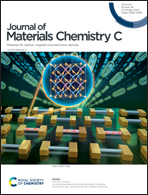A direct oriented-attachment growth of lead-chalcogenide mid-infrared nanocrystals film on amorphous substrates†
Abstract
Lead-chalcogenide nanocrystals (NCs), having unique properties including the large Bohr radius, multi-exciton generation, and low Auger recombination rates, have been well received as the main choice for infrared applications. To obtain high-quality NC films on chips, hetero-compatible crystalline substrates (e.g., GaAs) are commonly required. To avoid this substrate constraint, we developed a simple but non-trivial chemical deposition approach leading to a direct Oriented-Attachment (OA) growth of lead-chalcogenide NCs on amorphous substrates. Specifically, applying this new solution-based method, for the first time, (111) dominated PbSe NCs were uniformly assembled on glass slides forming mirror-like thin films of tunable quantum confining effect in the mid-infrared spectrum. Through a systematic inspection by using X-ray diffraction, electron backscatter diffraction, and photoluminescence methods, a new multi-stage OA growth model was then established to explain the dynamic chemical reaction process clearly, and thus offers a fundamentally new guideline for depositing oriented NCs on amorphous substrates directly.



 Please wait while we load your content...
Please wait while we load your content...